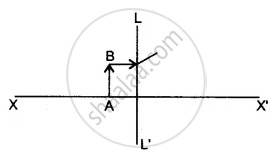Advertisements
Advertisements
Question
A normal eye is not able to see objects closer than 25 cm because
Options
the focal length of the eye is 25 cm
the distance of the retina from the eye-lens is 25 cm
the eye is not able to decrease the distance between the eye-lens and the retina beyond a limit
the eye is not able to decrease the focal length beyond a limit.
Solution
the eye is not able to decrease the focal length beyond a limit
The ciliary muscles adjust the focal length to form an image on the retina, but the muscles cannot be strained beyond a limit. Hence, if the object is brought too close to the eye, the focal length cannot be adjusted to form the image on the retina.
APPEARS IN
RELATED QUESTIONS
Calculate the focal length of a corrective lens having power +2D.
What is the focal length of a convex lens of focal length 30 cm in contact with a concave lens of focal length 20 cm? Is the system a converging or a diverging lens? Ignore thickness of the lenses.
Give the usual name for the following:
A point inside a lens through which the light passes undeviated.
Which of the two has a greater power: a lens of short focal length or a lens of large focal length?
What is the nature of a lens having a power of + 0.5 D?
The optician's prescription for a spectacle lens is marked +0.5 D. What is the:
(a) nature of spectacle lens?
(b) focal length of spectacle lens?
The focal length of a lens is +150 mm. What kind of lens is it and what is its power?
Fill in the following blank with suitable words :
The reciprocal of the focal length in metres gives you the _________ of the lens, which is measured in ___________.
An object of height 4.25 mm is placed at a distance of 10 cm from a convex lens of power +5D. Find (i) the focal length of the lens, and (ii) the size of the image.
A convex lens of focal length 25 cm and a concave lens of focal length 10 cm are placed in close contact with one another.
(a) What is the power of this combination?
(b) What is the focal length of this combination?
(c) Is this combination converging or diverging?
What is the unit of power of a lens? Define the unit of power of a lens.
A converging lens has a focal length of 50 cm. The power of this lens is:
How is the sign (+ or -) of power of a lens related to its divergent or convergent action?
A diverging lens of focal length 20 cm and a converging lens of focal length 30 cm are placed 15 cm apart with their principal axes coinciding. Where should an object be placed on the principal axis so that its image is formed at infinity?
How is accommodation produced?
Which lens has more power a thick lens or a thin lens?
The power of a lens is +2.0 D. Find its focal length and state the kind of lens.
Complete the diagram to show the formation of the image of the object AB.

(i) Name the Lens LL’.
(ii) Where is the image of the object AB formed?
(iii) State three characteristics of the image.
The power of the magnifying glass depends on the distance of the magnifying glass from object.
